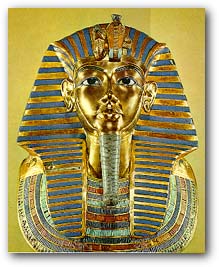Tutankhamun

Though small and unimpressive, Tutankhamun's Tomb is probably the most famous, due to its
late discovery. Howard Carter's description upon opening the tomb in 1922 was, "At first I
could see nothing, the hot air escaping from the chamber causing the candle flames to flicker,
but presently, as my eyes grew accustomed to the light, details of the room within emerged
slowly from the mist, strange animals, statues and gold - everywhere the glint of gold. For the
moment - an eternity it must have seemed to the others standing by - I was dumb with
amazement, and when Lord Carnarvon, unable to stand the suspense any longer, inquired
anxiously, 'Can you see anything?' it was all I could do to get out the words, "Yes, wonderful
things."' The royal seal on the door was found intact. The first three chambers were
unadorned, with evidence of early entrance through one of the outside walls. The next
chamber contained most of the funerary objects. The sarcophagus was four guilded wooden
shrines, one inside the other, within which lay the stone sarcophagus, three mummiform coffins,
the inner one being solid gold, and then the mummy. Haste can be seen in the reliefs and the
sarcophagus, due to the fact that Tutankhamun died at only 19 years of age following a brief
reign. Though extremely impressive to the modern world, the treasures of Tutankhamun must
have paled when compared to the tombs of the great Pharaohs that ruled for many years
during Egypt's golden age.
|





